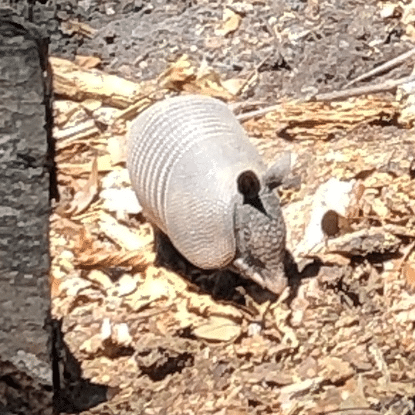The Nine-Banded Armadillo is an amazing creature. From their armor plates, ability to walk long distances, swim when they must, and varied diet, they are well-suited to a variety of habitats across the eastern U.S. – and spreading ever northward. Call them what you like and love them or hate them, they are tenacious creatures worthy of our respect.
There is some suggestion that this species is regaining a portion of its range after being pushed south during the last glacial period. Having only recently invaded the U.S. from Mexico and South America on their own four legs, starting in Texas with an initial sighting in 1854, they are now well-established across the south. They were purposely introduced to Florida in the 1920s. They have recently been reported in Nebraska and spreading northward along the east coast.
Regardless, they are considered invasive by many. For those of us with lawns and gardens, their excavations are not always welcomed, and yet they do consume what we humans consider other pests and create microhabitats for other creatures with their burrows. As with most animals, they have their place in the world, even if we do not understand or appreciate it.
Their migration was in part documented by roadkill records, a consequence of an unfortunate response of armadillos to being frightened. They go about their foraging using a keen sense of smell but are largely blind. They can jump straight up as high as three feet, a response that can deter predators. For them, the bottoms of moving vehicles are not kind, however, and these records continue to be used to determine their presence.
Aside from being seen dead along roadsides, these creatures have some unique qualities. For one, they and their 20 or so relatives are the only armored mammals in the world. Nine-banded armadillos typically have nine overlapping plates that provide protection from most predators. The number of plates can range between 7 and 11. They almost always have identical quadruplets, a result of the division of a single fertilized egg into four siblings. And they can run up to 30 miles per hour, a feat I can personally attest to.
As a child growing up in south Louisiana in the 1960s, armadillos were a common site and young fellas like myself were on the lookout for sets of quadruple siblings that would bring a handsome $25 reward from the local leprosy research facility. From a research perspective, having four genetically identical individuals has great value. Armadillos are susceptible to human leprosy and are used as a model in research on treatments. It is, however, rare to contract leprosy from wild animals.
I failed to catch any in my youth, having tried and failed to keep up with an adult I was scared one day. That experience did, however, inspire me to pull a fast one on a Filipino graduate student friend, unfamiliar with armadillos. My other southern partner in crime, Sam, and I did suggest to our friend Tus that it would be OK to walk up to the armadillo digging intently in a field – to snap a photo. We anticipated the scene well, as upon sensing the presence of our friend, both creatures leaped straight up, running in opposite directions when they hit the ground. We laughed, and our friend graciously forgave us.
Regardless of what you call them, armadillos (the little armored ones in Spanish), Hard-shelled Possums, Hoover hogs, or poor man’s pork, have value in our world. We can make room for them.
Hope to see you in our great outdoors!






